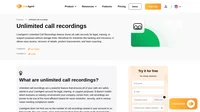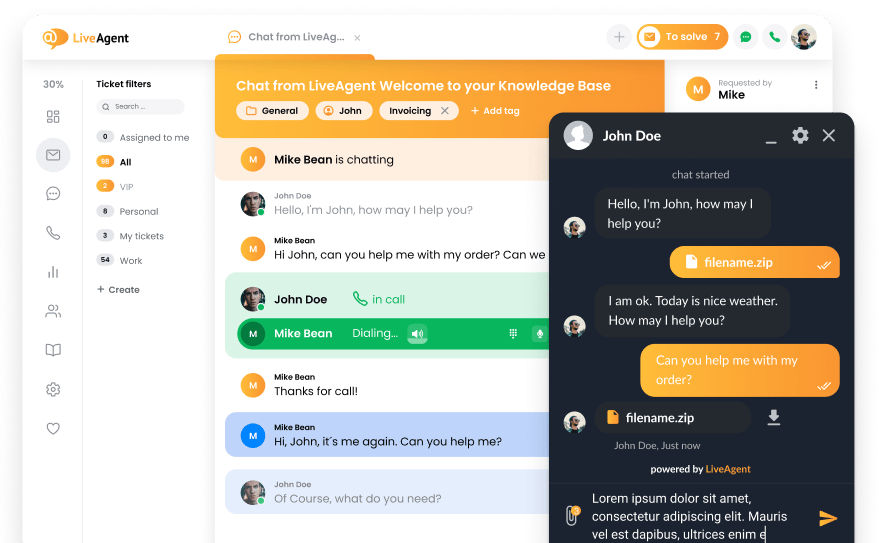Have you ever reached out to a customer support team, only to be bounced around from one agent to another? I know what you’re thinking: How great would it be to solve any issue right off the bat? This is where the importance of first contact resolution comes into play.
According to our data, the industry standards for satisfactory FCR are around 65-75%. If your FCR is below 65%, it doesn’t necessarily mean that your customer service performance is poor. It’s important to take into consideration the type of industry you operate in, as well as the complexity of your product or service. However, FCR rates that are close to 90% are generally considered high, while going below 40% is considered low.
But what does FCR stand for? Why is it so important for so many businesses? In this article, we’ll look into the FCR meaning in business and its impact on customer satisfaction and support efficiency. From understanding what FCR is to exploring its importance, benefits, and best FCR practices, we’ll also dive into how to measure FCR, common pitfalls to avoid, and more.
What is first contact resolution (FCR)?
First contact resolution (FCR) is a prime KPI example that refers to the ability of a customer support team to resolve customer inquiries during the initial interaction. This includes emails, calls, live chat messages, social media, and others. It measures the percentage of cases that are resolved without the need for a follow-up.
First contact resolution vs. first call resolution
There is a slight difference between first contact resolution and first call resolution. While they may sound similar, they have different meanings.
First contact resolution measures the percentage of support tickets that are successfully resolved during the initial point of contact, regardless of the communication channel used.
First call resolution refers to resolving customer issues during the first phone call. It measures how often a customer’s problem is resolved without any follow-up call or additional phone contact. Businesses strive to optimize this KPI by providing comprehensive resolutions during the initial customer contact, minimizing the need for further communication.
Both metrics are essential for measuring the effectiveness of your customer support. Still, first contact resolution offers a broader scope in terms of communication channels while FCR zooms in on phone call interactions.
Why is FCR important?
First contact resolution (FCR) is an important performance metric for every business that offers customer support because it helps to improve customer satisfaction and, therefore, drive customer loyalty. It also measures the efficiency of your agents and their ability to handle issues quickly and effectively, ultimately impacting the percentage of customers who become loyal and repeat buyers. All this combined can have a significant impact on the overall success of your business and your profitability.
Nevertheless, there are still many companies that don’t measure this KPI. If you are one of them, take a look at these few things this KPI proves to be useful for:
- Improving actual customer satisfaction
- Higher customer retention
- Increasing productivity
- Increased sales opportunities
- Enhancing the company’s image
The benefits of first contact resolution
Let’s take a closer look at the various advantages of FCR and what types of industries can benefit from it.
Improved customer satisfaction
Many people avoid contacting customer service. Some of the reasons may be long wait times, lack of responses from customer service team members, communicating with a chatbot that doesn’t understand the issue, or explaining the issue over and over again to different representatives. FCR reduces the customer effort and by resolving their issues during the first contact, it makes them feel valued and builds their trust in the brand. This can all lead to significant improvement in customer satisfaction and their experience.
Increased customer loyalty and retention
When the customer receives prompt and efficient solutions to their problem, they are more likely to remain loyal to your brand. Repeat business coupled with positive word-of-mouth recommendations can lead to long-term customer relationships and higher customer retention rates.
Higher agent productivity and satisfaction
Resolving tickets and customer issues during the first interaction reduces the need to handle the same customer request multiple times. This saves their time and allows them to focus on other customers, resulting in higher operational efficiency, productivity, and employee satisfaction. Being more efficient can also translate into more cost savings and optimized source allocation.
Stronger brand reputation
Businesses that focus on prioritizing FCR can be perceived as reliable and have a customer-centric approach. When a business has a satisfied customer base, it can contribute to a positive brand image, attract new clients, and boost its brand reputation.
Reduced customer support costs
FCR also has an impact on reducing customer support costs. By resolving customer issues during the initial contact, operational costs decrease as there is less need for follow-up interactions and resources can be allocated more efficiently. And because it also increases agent productivity by enabling them to handle more inquiries, it can reduce staffing costs. Moreover, higher FCR rates contribute to decreased customer churn and lower costs associated with customer acquisition.
Increased sales opportunities
By efficiently resolving issues during the initial customer interaction, businesses can create a positive customer experience, build trust and loyalty, and identify potential sales opportunities. Moreover, satisfied customers are more likely to repeat the purchase and become returning customers. It can also help to implement an upselling and cross-selling strategy – offering customers a complementary service or product during the purchasing process.
Some of the different industries that can benefit from FCR include:
- E-commerce: Customers frequently reach out to these companies with inquiries about orders, product details, or returns. By resolving these issues efficiently during the first contact, e-commerce businesses can reduce order cancellations and encourage repeat purchases.
- SaaS companies: Software as a Service (SaaS) companies receive customer queries on a daily basis regarding technical issues or product functionality. FCR helps address these concerns promptly, ensuring uninterrupted use of the software and maintaining customer loyalty.
- Call centers: To understand the FCR meaning in call center, let’s look at it this way: focusing on improving the first contact resolution rate can lead to higher customer satisfaction and, therefore, reduced call volumes. This, in turn, results in cost savings, increased agent productivity, and improved overall customer experience.
- Hospitality: Whether it’s hotel reservations, room service requests, or other guest inquiries, resolving these issues quickly improves the overall experience. Satisfied guests are more likely to leave positive reviews and return for future stays.
- Marketing agencies: These agencies receive client inquiries about things like campaign performance, strategy, or reporting. By addressing them promptly, agencies can demonstrate their expertise, strengthen client relationships, and ensure smooth campaign execution.
- Financial institutions: FCR is also essential for financial services providers, such as banks, insurance companies, or investment firms. Resolving inquiries about account management, financial planning, or claims during the first contact builds trust and enhances customer loyalty.
How to measure first contact resolution?
To work with the available data, you need to get them in plain old numbers so you can set achievable goals for yourself and your business.
- Determine a time frame: Choose a specific period to calculate the FCR metric (day, week, or month).
- Define what a resolution means in your case: Establish achievable goals and clear criteria for considering a customer query resolved (providing a solution, answering a question, addressing a concern, etc.).
- Collect data: Gather necessary information from various communication channels, including phone calls, emails, live chats, social media, or any other method used for customer support.
- Calculate the FCR metric: Use a simple formula to calculate the FCR.
The first contact resolution formula for gross FCR is as follows:
Gross FCR = Tickets resolved at first contact / Total number of incoming tickets
And the net FCR formula looks like this:
Net FCR = Tickets resolved at first contact / (All incoming tickets – Tickets that can’t be resolved at the first level)
Example: Let’s say your customer support team handled 100 inquiries in the course of one week. Out of those, 80 inquiries were resolved without the need for any follow-up interaction. In this case, the FCR would be calculated as follows:
FCR = (80/100) * 100 = 80%
The FCR metric equals 80%, which means that 80% of the customer inquiries were successfully resolved on the first contact.
What is a good FCR rate?
A good first contact resolution (FCR) rate typically depends on the type of industry a company operates in and the complexity of customer queries. While there is no universally perfect FCR rate, every company should aim for a higher percentage.
Benchmarking yourself against industry standards can give you an idea of what is considered a good FCR rate. For instance:
- E-commerce and retail industry: Retail and e-commerce is one of the highest-performing industries with an average FCR of 78%. This high percentage of customer inquiries that are solved during the first contact may be due to the fact that they are typically simpler – order tracking, product information, return policies, etc.
- Technology companies: On the other hand, tech support companies are ranked as companies with the lowest average FCR rate – around 65%. Technical support is often very time-consuming because it often deals with complex issues that can’t be solved during the first interaction.
- Call centers: The call center industry standard is around 71% on average which is an acceptable FCR rate. Call centers often provide support for various businesses which makes it more difficult to resolve customer inquiries during the first call.
- Financial institutions: These companies also have an average FCR of 71%. This sector includes banks, credit unions, lenders, and other financial institutions. Many of them offer a wide range of services which makes it harder to resolve issues during the first contact without the need to transfer the call to another department or have a follow-up communication.
While these examples provide a good overview of the standard FCR based on the industry or type of the company, it’s important to establish your own baseline and continuously work towards improving it.
6 Best practices for first contact resolution
If you want to achieve the best possible FCR rates, let’s get into some of the best practices you should consider implementing.
1. Document answers to common problems
By documenting your answers to common customer issues and problem-solving processes, it becomes much easier for support agents to provide accurate and consistent information quickly. Building an internal knowledge base allows you to have a centralized place where agents can find solutions to common issues, saving time and increasing the likelihood of resolving customer tickets during the initial contact. LiveAgent is a customer service software that allows you to create your internal knowledge base easily, and keep it clean and organized.
Additionally, it helps foster a culture of knowledge sharing and continuous improvement within your organization. When a team member faces unique or complex issues, they can document each step they took to resolve the problem and add it to the knowledge base library. This expands the repository of solutions, making it easier for future agents to handle similar cases.
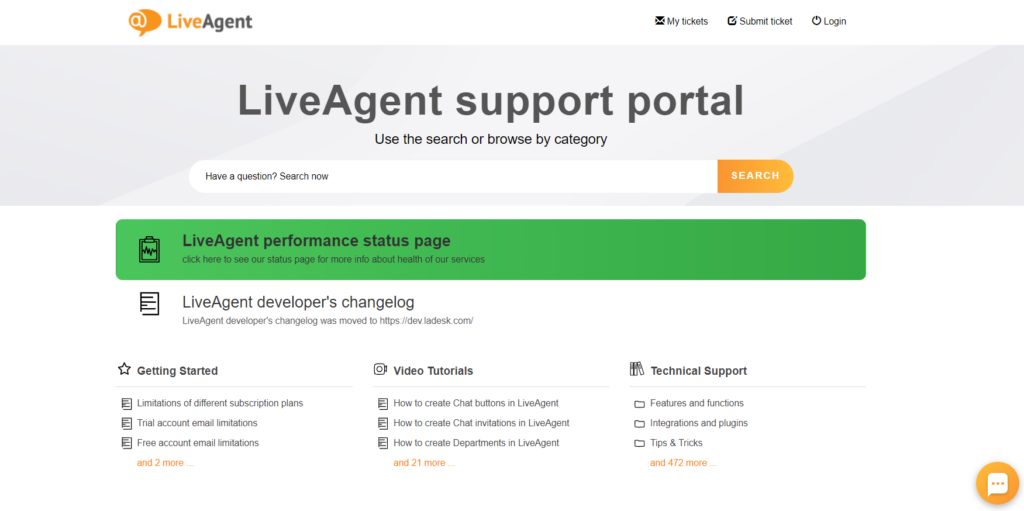
2. Respond to support inquiries quickly
Responding promptly to customer inquiries can also improve the first contact resolution rates. When a customer reaches out to the support team, they expect quick responses that have a significant impact on their experience. This positive impression at the start of the interaction sets the tone for a productive conversation and increases the chances of resolving the issue in the initial contact. It also prevents customers from being frustrated and looking for assistance through additional communication channels before receiving answers.
To help your customer support representatives provide these quick answers, you can take advantage of LiveAgent’s predefined answers to streamline your responses, enabling your team to provide timely and consistent support, as well as excellent customer service.
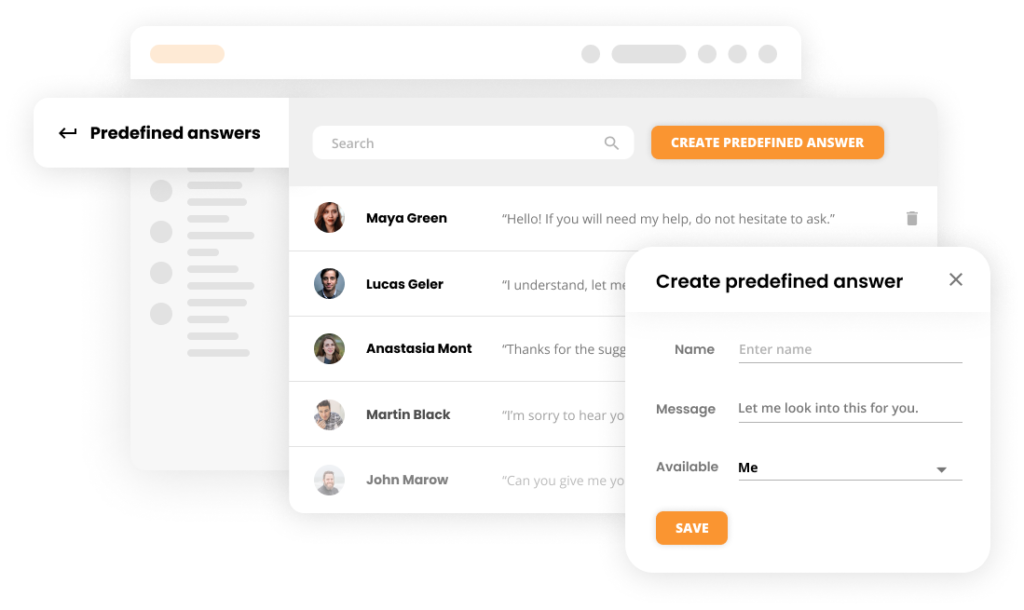
3. Provide clear instructions
In order to resolve an issue, the customer needs to understand the steps they need to take or actions that are required to resolve their issue. Therefore, providing clear instructions during the conversation between a customer and a support agent is crucial to improving FCR.
By breaking down more complex solutions into clear, step-by-step instructions, agents can guide customers through the troubleshooting or resolution process. This minimizes the chances of confusion, increasing the likelihood of successful resolution without the need for additional interactions.
4. Offer effective customer self-service options
A self-service portal is a powerful tool that can also improve the first contact resolution. It allows customers to find answers and solutions to their inquiries on their own, reducing the need for them to reach out for assistance. It provides instant access to information and self-service resources, such as FAQs, knowledge base articles, tutorials, and troubleshooting guides. Customers can simply search for their question or problem and find relevant resources to help them resolve it.
Additionally, the customer portal is available 24/7 which allows customers to access the portal at any time, even outside of regular business hours. This eliminates the frustration of having to wait for support during limited support hours. If you want to create a great and organized customer portal, you can check out LiveAgent.
5. Collect and act on customer feedback
Encourage your customers to leave feedback on their customer support experience during the initial contact. By seeking this feedback, you can gain valuable insights into the effectiveness of your customer support efforts and identify areas that can be improved.
Whether positive or negative, customer feedback can shed light on pain points and gaps in knowledge. By analyzing it, companies can take proactive steps to address the root of the issues and improve their FCR rates.
To do so, you can use tools such as LiveAgent’s feedback and suggestion feature to gather these insights and help you improve your support processes, ultimately leading to higher FCR rates.
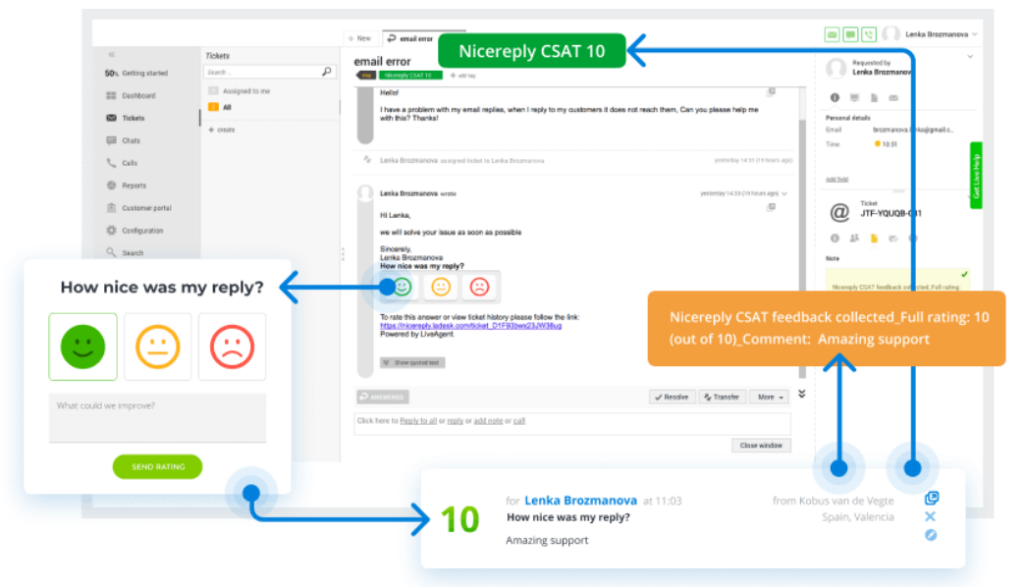
6. Set up the right analytics
Analytics provide valuable data that can be used to monitor and measure the FCR performance, identify common patterns, and pinpoint areas for improvement. By analyzing key contact center metrics such as FCR rate, average handling time, customer satisfaction scores (CSAT), or repeat contact rates, businesses can gain a clear understanding of their support team’s performance and customer satisfaction levels.
By utilizing the data analytic tools provided by LiveAgent, you can get insights that will help you make data-driven decisions. Identify specific areas where improvements are needed, refine processes, and allocate resources strategically to enhance FCR rates.
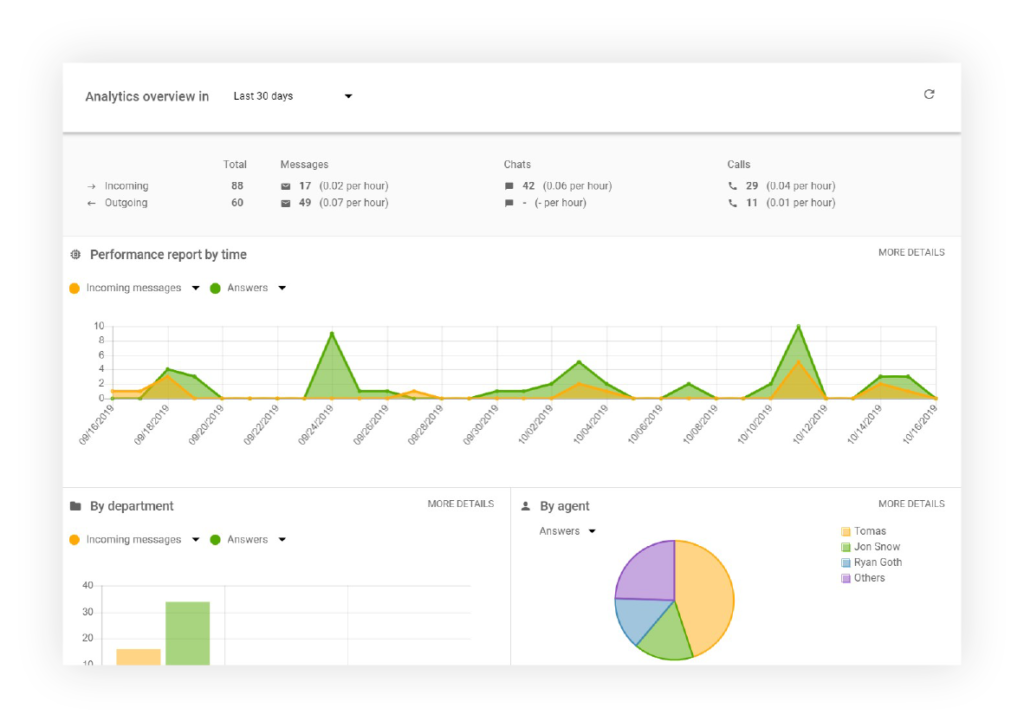
Common FCR pitfalls
There are some challenges that companies may encounter on their way to achieving high FCR rates. Let’s take a look at some of the common pitfalls.
Complex issues requiring multiple touchpoints: Some inquiries or issues may be more complex and require deeper investigation. This can make the resolution within the first contact difficult.
Example: Certain technical issues that involve troubleshooting or complex product knowledge may require collaboration between multiple different departments, leading to additional follow-up interactions.
Lack of specialized skills: There are certain issues that may require a specialized set of skills or knowledge that your support team might not possess. This leads to escalations or transfers, which affects your FCR rates.
Example: Healthcare organizations that are dealing with different medical inquiries may require specialized personnel such as doctors or nurses to provide accurate information, making immediate resolution quite challenging.
Insufficient training and resources: When your agents are not trained adequately or lack access to resources, they may struggle to address customer inquiries effectively. Limited resources and outdated information can lead to delays in finding solutions and therefore, lower FCR rates.
Example: A technology company can receive an inquiry regarding a software integration issue. The support agent initially tries to troubleshoot the problem but realizes that it requires collaboration with the development team. This leads to a transfer, resulting in multiple touchpoints and a decrease in the FCR rate.
To avoid these common pitfalls, you can consider:
- Providing comprehensive agent training methods to your support team to enhance their skills and knowledge.
- Ensuring effective communication and collaboration between different departments to streamline issue resolution.
- Building comprehensive online knowledge bases that are continuously updated to always provide accurate information.
- Implementing tools and technologies such as LiveAgent that facilitate seamless information sharing and enable agents to access resources efficiently.
Watch how to measure FCR
Immerse yourself in the world of first contact resolution with our informative video. Explore how this critical customer support metric plays a pivotal role in enhancing efficiency and customer satisfaction. Learn about the strategies and techniques that empower support teams to resolve customer issues swiftly and effectively, right from the first interaction.

Conclusion
The first contact resolution (FCR) is a key metric in customer support that measures the ability to resolve issues during the initial interaction. By focusing on promptly resolving these problems, businesses can enhance customer satisfaction, brand reputation, and operational efficiency.
Implementing best practices such as documenting solutions, providing clear instructions, and offering self-service options can help improve your FCR rates. However, challenges like complex issues and the need for specialized skills may affect FCR.
By investing in training, resources, and effective communication, businesses can overcome these obstacles and strive for higher FCR rates, which ultimately leads to happier customers and streamlined support experiences.
You can try out LiveAgents 30-day free trial and increase your first contact resolution rates by implementing our reliable customer service software.
Shorten your resolution times with LiveAgent
LiveAgent's ticketing system can help you with faster, efficient, and professional answers to any customer ticket. Get started with our free trial today.
Frequently Asked Questions
How do I improve my contact call resolution?
To improve your contact call resolution, focus on the following steps: provide comprehensive training to your customer service agents, ensure they have access to updated resources, and implement efficient communication and collaboration processes between teams. By equipping your team with the right skills and resources, you can increase the likelihood of resolving customer issues during the first call.
How do you calculate first contact resolution?
To calculate your FCR, take the number of inquiries that are resolved during the initial interaction and divide it by the total number of customer inquiries within a defined time frame. Multiply the result by 100 to obtain the FCR percentage.
What is the difference between FCR and FTR?
First contact resolution (FCR) measures the percentage of customer issues that are resolved during the initial interaction. First touch resolution (FTR) measures the percentage of customer issues that are resolved within the first touchpoint, regardless of whether it is the first interaction or a follow-up interaction.
What is FCR in the ticketing system?
In a ticketing system, FCR stands for First Contact Resolution. It refers to the percentage of customer support tickets that are resolved during the initial interaction between the customer and the customer support representative, without the need for any further follow-up or escalation.
What is one-call resolution vs. first call resolution?
One-call resolution refers to resolving issues in a single customer call, regardless of whether it is the first call or a subsequent call. First call resolution focuses on resolving customer issues during the first phone call, measuring the percentage of customer inquiries that are resolved without any follow-up call or subsequent phone interactions.
After learning about First Contact Resolution, you might be interested in exploring the First Contact Resolution Tips & Pitfalls. This article covers essential tips and common pitfalls to avoid, helping you enhance your customer support strategies. Another valuable read is about the First Contact Resolution Rate, where you'll find insights on calculating and improving this crucial metric. Lastly, don't miss the guide on First Call Resolution, which explains the significance of resolving issues on the first call and offers best practices to achieve it effectively.
Enhance your customer service with LiveAgent's help desk tags. Organize and categorize tickets efficiently using tags, automation rules, and reports to boost agent productivity, improve response times, and increase customer satisfaction and revenue. Try LiveAgent's tag features with a free trial today!

 Български
Български  Čeština
Čeština  Dansk
Dansk  Deutsch
Deutsch  Eesti
Eesti  Español
Español  Français
Français  Ελληνικα
Ελληνικα  Hrvatski
Hrvatski  Italiano
Italiano  Latviešu
Latviešu  Lietuviškai
Lietuviškai  Magyar
Magyar  Nederlands
Nederlands  Norsk bokmål
Norsk bokmål  Polski
Polski  Română
Română  Русский
Русский  Slovenčina
Slovenčina  Slovenščina
Slovenščina  简体中文
简体中文  Tagalog
Tagalog  Tiếng Việt
Tiếng Việt  العربية
العربية  Português
Português 

